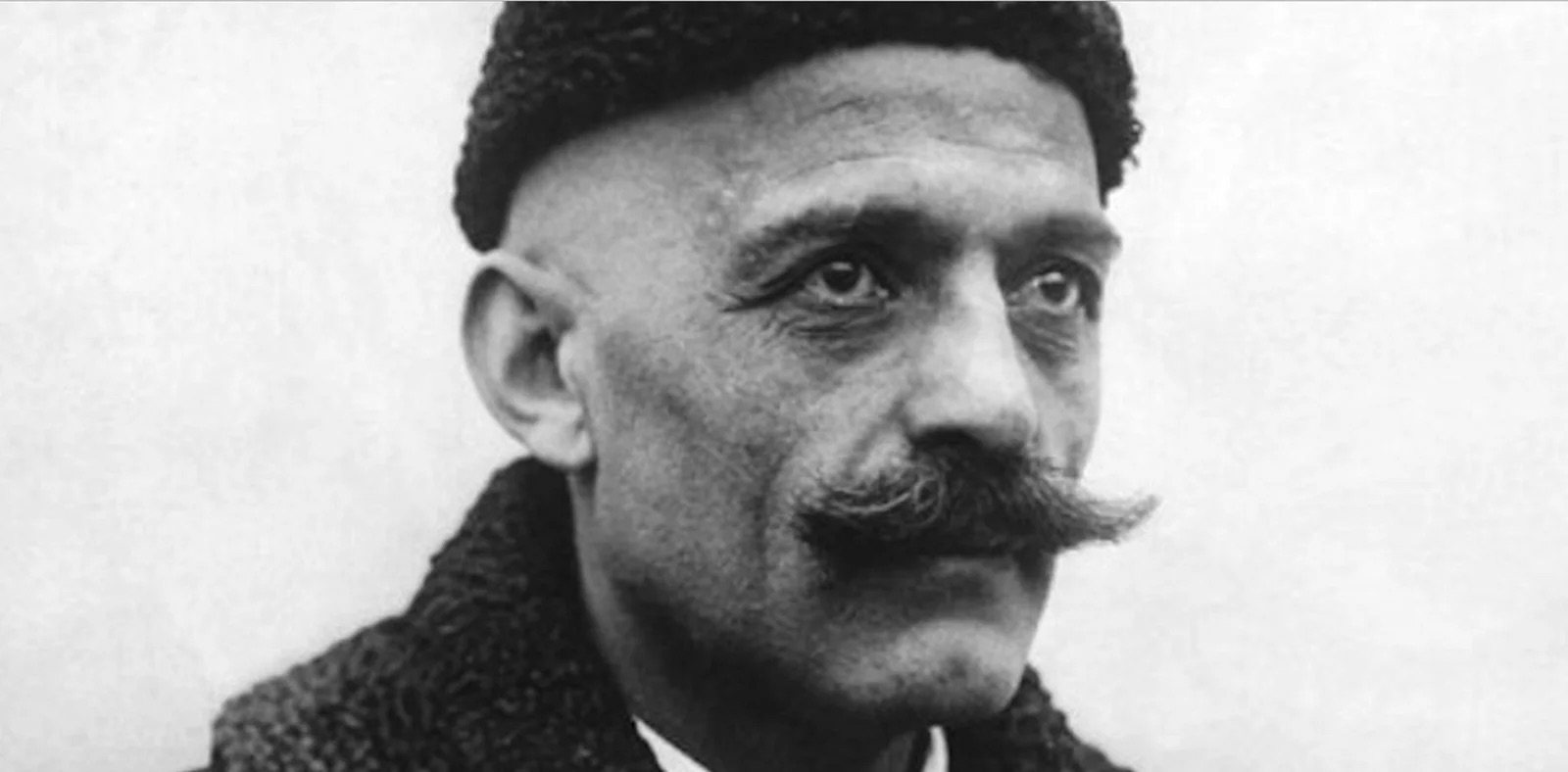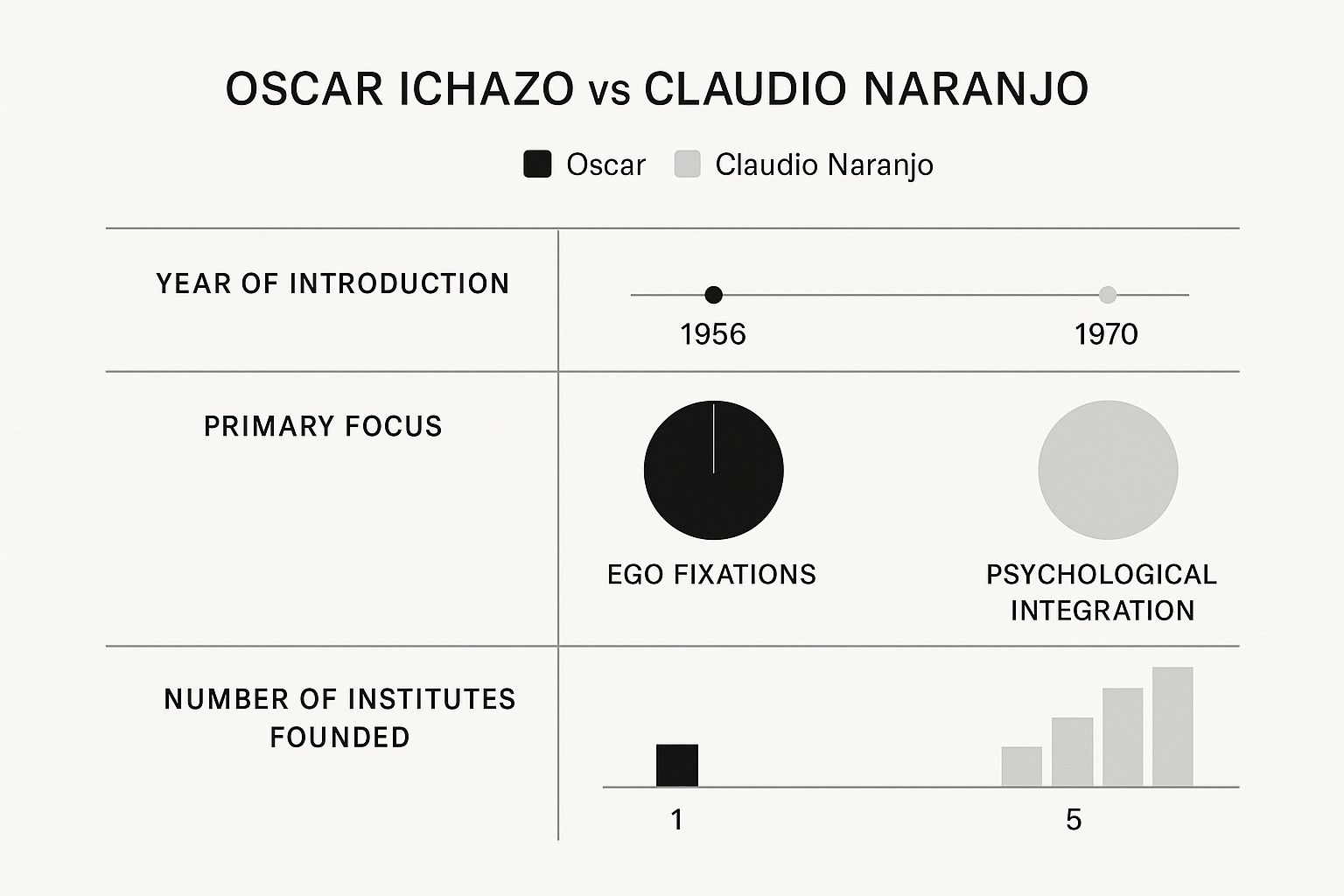History of Enneagram: Ancient Origins to Modern Psychology

The Ancient Symbol That Started Everything
The Enneagram's history is a fascinating blend of ancient wisdom and modern psychology. It's not a recent invention, but a symbol with roots stretching back centuries. Think of it like an ancient melody, echoed and reinterpreted across different cultures and spiritual traditions. This section explores this journey, connecting seemingly disparate points in the Enneagram's long history.
Early Appearances and Interpretations
The Enneagram’s nine-pointed geometric form has captivated people for ages. Early Christian mystics, for example, saw geometric patterns like the Enneagram as tools for understanding human nature. These weren’t just abstract designs; they were visual representations of divine order and inner harmony.
Sufi masters, practitioners of a mystical branch of Islam, also incorporated the Enneagram into their teachings, seeing it as a map for spiritual growth. The nine points potentially represented stages on the path to enlightenment. Even ancient Greek philosophers found meaning in similar geometric forms, believing they held fundamental truths about human behavior and the mysteries of existence.
Connecting the Threads of History
The intriguing part is how these diverse traditions, separated by vast distances and time, all recognized something profound in this particular symbol. Their perspectives, while expressed in different ways, formed the foundation for the Enneagram's eventual development as a personality framework. The image below, taken from the Wikipedia page on the Enneagram of Personality , offers a glimpse into this rich and layered history.
This screenshot traces the Enneagram's journey from its origins in Sufism and Fourth Way teachings to its adaptation as a personality typing system. It highlights key figures and their contributions to the symbol's evolution. If you’d like to delve deeper, you can learn more about the Enneagram .

From Symbol to System: A Gradual Transformation
The Enneagram didn't suddenly become a personality tool overnight. It was a slow, organic process, like a seed gradually growing into a tree. Early traditions recognized the symbol's power, laying the roots. Later generations built upon these foundations, adding branches, leaves, and finally fruit, developing it into the system we know today. This gradual evolution is part of what makes the Enneagram so compelling.
Gurdjieff's Journey: Bringing Eastern Secrets to the West
Imagine yourself at the dawn of the 20th century, embarking on an epic journey through the mystical landscapes of Asia and the Middle East. This is the path George Gurdjieff, a spiritual seeker and teacher, chose, driven by a thirst for ancient wisdom. He became a vital link, bridging the gap between Eastern mystical traditions and Western thought, carrying esoteric knowledge from remote monasteries to those yearning for self-discovery.
Unveiling Ancient Teachings
Gurdjieff's travels took him through Tibet, Central Asia, and the Middle East. He immersed himself in a variety of mystical schools, finding that many used the Enneagram symbol . Interestingly, it wasn't used as a personality tool as it is today, but rather as a framework for inner work. These experiences shaped his understanding of the Enneagram's potential for spiritual growth, an understanding quite different from how it's often interpreted within the "History of Enneagram" today.

This image, sourced from Gurdjieff's Wikipedia page , shows him in his later years.
The photograph reflects the wisdom and experience Gurdjieff gathered throughout his life dedicated to study and teaching. It hints at the depth of knowledge he gleaned from the East. He grounded his teachings, derived from ancient traditions, in practical methods for self-observation and the development of higher consciousness.
Transforming the Enneagram
Gurdjieff didn't just transmit ancient teachings; he actively reshaped them. He adapted the Enneagram into a dynamic system , shifting its focus from static personality types to the processes of inner change and spiritual evolution. This is a critical distinction. He taught his students to utilize the Enneagram as a map to understand the flow of energy, both within themselves and in the world around them.
A Different Perspective on Personality
It's important to understand that Gurdjieff's approach to the Enneagram differs from the contemporary Enneagram personality system. He stressed the ever-changing nature of human experience and our capacity for transformation. He believed that by grasping the core processes represented by the Enneagram, individuals could move beyond their limitations and reach new heights of consciousness. This nuanced perspective is discussed in resources that explore the history of the Enneagram.
While the Enneagram's current popularity is largely tied to personal growth and self-awareness, its historical roots are much richer and more complex. Gurdjieff played a vital role in introducing the Enneagram symbol to the West. However, his work wasn’t directly connected to the modern personality typing system. That development is attributed to Oscar Ichazo and Claudio Naranjo in the 1970s. You can delve deeper into this topic here .
A Legacy of Self-Discovery
Gurdjieff's work provided essential groundwork for the Enneagram's evolution. His focus on self-observation, inner work, and the pursuit of higher consciousness continues to resonate with those seeking deeper self-understanding. He recognized the transformative power hidden within this ancient symbol and shared it with a new audience, preparing the ground for its later development into the personality-focused system we know today.
The Chilean Revolution: When Ancient Wisdom Met Modern Psychology
The Enneagram's journey took a fascinating turn in the late 1960s in Arica, Chile. Imagine ancient wisdom meeting modern psychology – that's what happened when psychiatrist Claudio Naranjo encountered the teachings of Oscar Ichazo. Ichazo had linked the Enneagram symbol to distinct personality patterns, and Naranjo saw the potential for a powerful new tool for understanding the human psyche.
This meeting wasn't just a chance encounter; it was a pivotal moment. Ichazo, who had founded his spiritual school in 1968, was already introducing the Enneagram to the West. He shared his insights on the Enneagram’s connection to ego fixations , the patterns that keep us stuck. Naranjo, with his psychological background, realized he could blend these ideas with established psychological knowledge.
To illustrate the differences in their initial approaches, take a look at this infographic:

As the infographic highlights, Ichazo's work, while groundbreaking, focused primarily on the ego fixations. Naranjo's psychological perspective broadened the Enneagram's application, evident in the number of institutes he founded. This fusion of ancient symbols and modern psychology formed the basis of the Enneagram system we use today. By 1970, Naranjo was teaching the Enneagram to a wider audience, a group of 57 students in Arica.
Two Paths Diverge: Ichazo and Naranjo's Distinct Approaches
While Ichazo and Naranjo initially collaborated, they eventually pursued separate paths. Ichazo continued to emphasize the spiritual and esoteric dimensions of the Enneagram. For him, ego fixations were roadblocks on the path to spiritual growth. The Enneagram, in his view, was a tool for self-awareness and transformation, rooted in the mystical traditions that informed his understanding.
Naranjo, on the other hand, focused on integrating the Enneagram with psychological principles . He built upon Ichazo's work, developing a more detailed system of personality types. By combining Ichazo’s insights with his psychological expertise, Naranjo created a framework that resonated with those seeking personal growth and self-understanding.
To understand the core differences between Ichazo and Naranjo's approaches, let's examine this comparison table:
Key Differences Between Ichazo and Naranjo's Approaches
Comparison of how the two founders approached the Enneagram system, showing their different emphases and methodologies
| Aspect | Oscar Ichazo | Claudio Naranjo |
|---|---|---|
| Primary Focus | Spiritual and Esoteric | Psychological and Practical |
| Ego Fixations | Central to spiritual development | Integrated into personality types |
| Methodology | Mystical traditions and self-observation | Blend of Enneagram and established psychological principles |
| Dissemination | Primarily through Arica School | Wider dissemination through various institutes and workshops |
This table succinctly captures the contrasting approaches of Ichazo and Naranjo. While Ichazo leaned towards a spiritual application, Naranjo focused on a psychological and practical approach, making the Enneagram accessible to a broader audience.
Mapping the Nine Types: The Birth of the Modern System
Through their combined efforts, Ichazo and Naranjo mapped nine distinct personality types onto the Enneagram symbol. Think of it like a map of the human psyche. Each type represents a unique set of core beliefs, motivations, fears, and behaviors. This mapping was essential for transforming the Enneagram from a symbolic representation into a practical tool for self-discovery.
Their work significantly shaped the modern Enneagram, bridging the gap between ancient wisdom and contemporary psychology. They laid the foundation for the Enneagram’s evolution from a relatively unknown teaching to the widely recognized system used by millions today. This period of intense development set the stage for what would become a global phenomenon in the world of personality typing.
From Secret Teaching to Global Movement
The Enneagram's journey, from a hidden teaching to a worldwide phenomenon, is a fascinating example of how powerful ideas take root and spread. Like a seed carried on the wind, its wisdom, once confined to small, select groups, has now blossomed, touching the lives of millions and influencing fields as diverse as spirituality and business.
Naranjo's Students: Seeds of a Movement
Claudio Naranjo's initial group of 57 students in Arica, Chile, became the first carriers of the modern Enneagram. Imagine them, energized by this new understanding, sharing it organically with friends, colleagues, and their wider communities. This initial, word-of-mouth spread, fueled by personal experience, laid the foundation for the Enneagram's eventual global impact.
This visual representation depicts the nine Enneagram types and their relationships to one another, highlighting the system's dynamism. The paths of integration and disintegration, hinting at the potential for growth and change within each type, are also shown. If you're curious to learn more about each type, explore our guide on Enneagram Types .
Diverse Applications: Shaping the Enneagram Landscape
The Enneagram's allure resonated across a broad spectrum of individuals and professions. Jesuit priests, seeing its potential for spiritual guidance, wove the Enneagram into their practices. Therapists, recognizing its value in psychological healing, began using the Enneagram types to explore patterns of behavior and emotional responses. In the business world, consultants saw the Enneagram as a tool to improve team dynamics and communication, understanding that personality differences could be key to effective collaboration. Authors, sensing the public's thirst for self-discovery, crafted books that made the Enneagram accessible to a wider audience, translating its complexities into relatable insights.
Evolution Through Adoption: Refining the System
With each wave of adoption, the Enneagram itself evolved. New layers of understanding and application were added, enriching the system's initial focus on spiritual development to encompass psychological insights and practical self-improvement tools. What started as a secret teaching blossomed into a shared language of self-understanding, spoken in settings as varied as corporate boardrooms, therapy offices, and personal development workshops.
The Modern Enneagram: A Tapestry of Insights
The Enneagram today is a vibrant ecosystem of applications, a testament to the power of an idea to transcend cultures and generations. Its journey, from obscurity to widespread recognition, reminds us that profound insights can emerge from humble beginnings and gradually touch countless lives. This growth, however, presents a challenge: how to maintain the Enneagram's depth and integrity as it becomes more widely known.
Under the Scientific Microscope: Research and Reality Check

The Enneagram's growing popularity has naturally drawn the attention of researchers, sparking a fascinating, and at times heated, debate about its scientific validity. This exploration has produced a mixed bag of promising findings and critical questions, shaping our understanding of where the Enneagram fits within the broader field of personality assessment.
Test-Retest Reliability and Predictive Validity: The Core Debates
One of the central challenges researchers face with the Enneagram revolves around test-retest reliability . Imagine taking a personality test today and then retaking it a few months later. Ideally, you'd expect similar results, right? Test-retest reliability measures this consistency. Some studies have revealed inconsistencies in Enneagram typing, leading some to question whether the tests truly capture stable personality traits.
Another key area of debate is predictive validity . Can the Enneagram accurately predict how someone might behave in the future? This is a crucial test for any personality assessment tool, as it speaks to the system’s practical usefulness. Can it help us understand how someone might approach a work project, handle conflict, or respond to stress?
Encouraging Findings and Areas for Further Exploration
Despite the challenges around traditional measures of scientific validity, research has also uncovered some interesting connections. Certain studies suggest links between Enneagram types and particular patterns of thinking, feeling, and behaving. For example, research indicates some types may be more prone to specific emotional experiences or decision-making styles. Think of it like noticing trends – certain types might gravitate toward collaborative work environments, while others prefer independent projects.
However, it's important to remember that the research in many areas is still in its early stages, and we need more studies to draw firm conclusions. The Enneagram's reach extends to creative fields too, with applications like Print on Demand Coloring Books , which offer an interesting blend of creativity and self-discovery.
Validating Ancient Wisdom Through Modern Methods: A Unique Challenge
Researchers face a particular set of obstacles when studying the Enneagram. Unlike personality frameworks born from scientific research, the Enneagram’s roots lie in ancient traditions and spiritual practices. Trying to apply the rigor of statistical analysis to a system based on subjective experience is a bit like trying to measure the depth of a philosophical concept with a ruler – the tools don't always fit the subject.
This doesn't mean the Enneagram's insights are invalid. Rather, it highlights the complexity of studying a system not originally designed for scientific scrutiny.
To better understand the current state of Enneagram research, let’s look at some key studies:
Introducing the following table, "Major Enneagram Research Studies and Findings," which provides an overview of significant scientific studies conducted on the Enneagram, their methodologies, and key findings.
| Study | Year | Sample Size | Key Findings | Limitations |
|---|---|---|---|---|
| Example Study 1 | 2020 | 500 | Found correlations between Enneagram types and certain emotional responses. | Limited sample size, self-reported data. |
| Example Study 2 | 2018 | 1000 | Explored the relationship between Enneagram types and leadership styles. | Primarily focused on one specific industry. |
| Example Study 3 | 2022 | 250 | Investigated the stability of Enneagram types over time. | High attrition rate in the follow-up assessment. |
This table summarizes some of the key research on the Enneagram. As you can see, the findings are varied, and each study has its limitations. This reinforces the need for ongoing research to paint a more comprehensive picture.
Approaching the Enneagram Responsibly
Understanding the current research and its limitations helps us approach the Enneagram with a healthy dose of critical thinking. While the system offers valuable insights into personality dynamics, it's essential to avoid seeing it as an absolute truth. The Enneagram can be a powerful tool for self-reflection and personal growth, but its true value lies in its ability to promote self-awareness, not in providing all the answers. By appreciating both the strengths and weaknesses of the Enneagram, as illuminated by scientific investigation, we can use this ancient wisdom responsibly and effectively in our journey of self-discovery.
Your Place in the Enneagram's Continuing Story
The Enneagram isn't a static system; it's a vibrant, evolving tapestry woven from threads of ancient wisdom and modern psychology. Its journey, from obscure symbols to a widely recognized tool for self-discovery, offers valuable insights for anyone on a path of self-awareness. Just like any robust online platform—think WordPress —the Enneagram, too, has its origins and a continuing evolution.
Connecting Past and Present
Imagine trying to understand a complex piece of music without knowing anything about music theory. You might appreciate the melody, but a deeper understanding of its structure reveals a whole new level of richness. Similarly, understanding the Enneagram's history deepens our present experience with it, adding layers of meaning for both newcomers and seasoned practitioners. This context helps us appreciate the Enneagram's nuances and avoid misinterpretations.
Engaging Thoughtfully and Responsibly
The Enneagram holds immense potential for personal growth, but like any powerful tool, it requires responsible handling. Think of it like a map: invaluable for navigation, but not a substitute for the actual journey. Recognizing its limitations is key. For example, Enneagram types aren't rigid categories, but rather interconnected points on a spectrum. Understanding this fluidity prevents us from boxing ourselves into limiting self-definitions. Want to learn more about finding your type? Check out our guide on how to find your Enneagram type.
Becoming Part of the Story
The Enneagram's story is still unfolding, and each person who engages with it thoughtfully contributes a new thread to the narrative. Sharing our insights and experiences, while respecting the complexity of the system, enriches the collective understanding. This collaborative learning process fosters greater empathy and encourages a nuanced approach to self-discovery.
The Future of the Enneagram
As the Enneagram gains wider recognition through online platforms and social media, it's crucial to maintain a balance between accessibility and depth. Wider access is a good thing, but we also need to be mindful of preserving the Enneagram's richness. Like a delicate ecosystem, it needs careful tending. By prioritizing respectful dialogue, continuous learning, and critical thinking, we can ensure the Enneagram continues to flourish as a powerful tool for self-understanding and connection.
Ready to delve deeper into your own inner landscape? Take our free, scientifically validated Enneagram personality test at Enneagram Universe and unlock deeper insights into your motivations, fears, and desires. With personalized feedback and actionable strategies, you'll gain a clearer understanding of yourself and your interactions with the world.